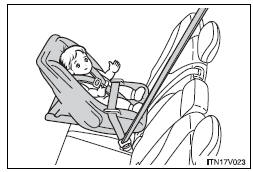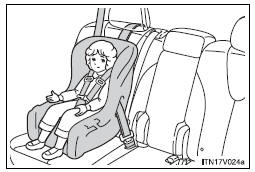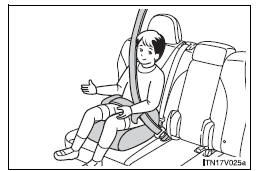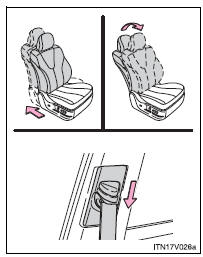Toyota Venza: Types of child restraints
Child restraint systems are classified into the following 3 types according to the age and size of the child.
► Rear facing -- Infant seat/convertible seat

► Forward facing -- Convertible seat

► Booster seat

- When installing the child restraint system on the front passenger seat

When you have to use a child restraint system on the front passenger seat, adjust the following:
• The seatback to the most upright position • The seat cushion to the fully rearward • The seat belt height to the lowest position
- Selecting an appropriate child restraint system
• Use a child restraint system appropriate for the child until the child becomes large enough to properly wear the vehicle’s seat belt.
• If a child is too large for a child restraint system, sit the child on a rear seat and use the vehicle’s seat belt.
CAUTION
- Child restraint precautions
• For effective protection in automobile accidents and sudden stops, a child must be properly restrained, using a seat belt or child restraint system depending on the age and size of the child. Holding a child in your arms is not a substitute for a child restraint system. In an accident, the child can be crushed against the windshield, or between you and the vehicle’s interior.
• Toyota strongly urges the use of a proper child restraint system that conforms to the size of the child, installed on the rear seat. According to accident statistics, the child is safer when properly restrained in the rear seat than in the front seat.
• Never install a rear-facing child restraint system on the front passenger seat even if “AIR BAG OFF” indicator light illuminates. In the event of an accident, the force of the rapid inflation of the front passenger airbag can cause death or serious injury to the child if the rear-facing child restraint system is installed on the front passenger seat.
• A forward-facing child restraint system may be installed on the front passenger seat only when it is unavoidable. A child restraint system that requires a top tether strap should not be used in the front passenger seat since there is no top tether strap anchor for the front passenger seat.
Adjust the seatback as upright as possible and always move the seat as far back as possible even if “AIR BAG OFF” indicator light is illuminated, because the front passenger airbag could inflate with considerable speed and force. Otherwise, the child may be killed or seriously injured.
CAUTION
- Child restraint precautions
• Do not use the seat belt extender when installing a child restraint system on the front or rear passenger seat. If installing a child restraint system with the seat belt extender connected to the seat belt, the seat belt will not securely hold the child restraint system, which could cause death or serious injury to the child or other passengers in the event of a sudden stop, sudden swerve or an accident.
• Do not allow the child to lean his/her head or any part of his/her body against the door or the area of the seat, front, center and rear pillars or roof side rail from which the side airbags or curtain shield airbags deploy even if the child is seated in the child restraint system. It is dangerous if the side airbags and curtain shield airbags inflate, and the impact could cause death or serious injury to the child.
• Make sure you have complied with all installation instructions provided by the child restraint manufacturer and that the system is properly secured. If it is not secured properly, it may cause death or serious injury to the child in the event of a sudden stop, sudden swerve or an accident.
- When children are in the vehicle
Do not allow children to play with the seat belt. If the belt becomes twisted around
a child’s neck, it may lead to choking or other serious injuries that could result
in death.
If this occurs and the buckle cannot be unfastened, scissors should be used to cut the belt.
CAUTION
- When the child restraint system is not in use
• Keep the child restraint system properly secured on the seat even if it is not in use. Do not store the restraint unsecured in the passenger compartment.
• If it is necessary to detach the child restraint system, remove it from the vehicle or store it securely in the luggage compartment. This will prevent it from injuring passengers in the event of a sudden stop, sudden swerve or an accident.
 Points to remember
Points to remember
Studies have shown that installing a child restraint on a rear seat is much safer
than installing one to the front passenger seat.
• Choose a child restraint system that suits your vehicle and is ...
 Installing child restraints
Installing child restraints
Follow the child restraint system manufacturer’s instructions. Firmly secure
child restraints to the rear seats using the LATCH anchors or a seat belt. Attach
the top tether strap when installin ...
Other materials about Toyota Venza:
One or more Power Seat Motors do not Operate
DESCRIPTION
Signals are input into the position control ECU and switch assembly. The built-in
ECU manages the signals received from the position control ECU and switch assembly,
and operates each motor. If the position control ECU and switch assembly rece ...
Crankshaft Position - Camshaft Position Correlation (Bank 1 Sensor A) (P0016,P0017)
DESCRIPTION
In the VVT (Variable Valve Timing) system, the appropriate intake and exhaust
valve open and close timing is controlled by the ECM. The ECM performs intake and
exhaust valve control by performing the following: 1) controlling the camshaft and ...
Power Mirror Surface Position is not Memorized
SYSTEM DESCRIPTION
If either the M1 or M2 seat memory switch is pressed, the outer mirror control
ECU assembly (driver door) detects the switch operation and sends the seat memory
switch signal to the main body ECU (driver side junction block assembly) vi ...
0.1305
